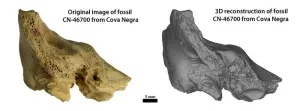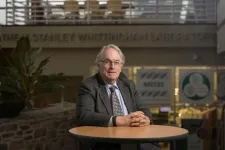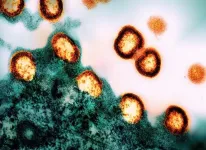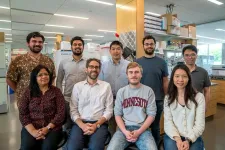(Press-News.org) Scientists at the University of Konstanz in Germany have advanced ultrafast electron microscopy to unprecedented time resolution. Reporting in Science Advances, the research team presents a method for the all-optical control, compression, and characterization of electron pulses within a transmission electron microscope using terahertz light. Additionally, the researchers have discovered substantial anti-correlations in the time domain for two-electron and three-electron states, providing deeper insight into the quantum physics of free electrons.
Background and Challenges
Ultrafast electron microscopy is a cutting-edge technique that combines the spatial resolution of traditional electron microscopy with the temporal resolution of ultrafast femtosecond laser pulses. This powerful combination allows researchers to observe atoms and electrons in motion, capturing dynamic processes in materials with unparalleled clarity. By visualizing these rapid events in space and time, scientists can gain deeper insights into the fundamental mechanisms that govern material properties and transitions, helping to create advancements in research fields such as nanotechnology, optics, materials science, and quantum physics.
Although ultrafast electron microscopy enables, in principle, the observation of atomic and electronic motions on fundamental spatial and temporal scales, capturing these rapid dynamics has remained challenging due to the limitations in electron pulse duration. The current standard electron pulses, lasting about 200 femtoseconds, are too long to resolve many fundamental reaction processes in materials and molecules. Pulses ten times shorter would be required to observe basic reaction paths and collective atomic motions, so-called phonon modes, in real time.
Generation of ultrashort electron pulses
Now, the Konstanz team has introduced a groundbreaking approach to advance the time resolution of transmission electron microscopy from hundreds to tens of femtoseconds. The researchers utilize a single optical cycle of terahertz light to manipulate the electron pulses in space and time on the dimensions of single-cycle laser light. This method not only preserves the spatial resolution of the electron microscope but also enhances its temporal resolution to the regime of visualizing atomic and potentially even electronic motions on fundamental scales.
“One of the primary challenges in ultrafast electron microscopy is the unavoidable energy bandwidth of ultrafast photoemission from a laser-triggered needle tip. Due to the dispersion of vacuum for non-relativistic electrons with rest mass, this energy bandwidth unavoidably leads to quantum-mechanical wave packet dispersion and pulse lengthening in time,” explains Peter Baum, head of the Light and Matter Group at the University of Konstanz. The team overcame this problem by utilizing the electric field gradient of terahertz pulses to accelerate the trailing part and decelerate the leading part of the electron wave function, resulting in significantly compressed pulses at the specimen. Due to the limited available space inside of the microscope, the team achieved this control by employing a metallic parallel-plate waveguide to generate the necessary sub-cycle field-electron interactions at sufficient spatial homogeneity and minimized aberrations. “A key aspect of our approach lies in the special electric and magnetic fields generated within the waveguide. By designing a waveguide that creates a standing terahertz wave with precise phase control, we can amplify electric fields while canceling out unwanted magnetic fields. This configuration allows for the acceleration and deceleration of electron pulses without introducing spatial aberrations,” summarizes Joel Kuttruff, the PhD student who designed the experiment.
Using this idea, the team has successfully compressed their electron pulses from over 200 femtoseconds to just 19 femtoseconds. This advance promotes the time resolution of electron microscopy into the domain of fundamental atomic dynamics and reaction paths. “Even at the enhanced temporal resolution, the spatial resolution of the microscope remains almost uncompromised” says Peter Baum. In the experiments, microscope images and diffraction patterns of gold nanoparticles and silicon crystals demonstrate these clear and precise imaging capabilities at, now, an unprecedented resolution in the time domain.
Correlations in multi-electron states
In a first application of their novel capabilities, the researchers have measured two-electron and three-electron states and have discovered substantial anti-correlations in the time domain, providing deeper insight into the interactions and dynamics of multi-electron systems. “When one electron arrives early, the other arrives late, and vice versa, creating a clear temporal separation between the two,“ explains David Nabben, postdoctoral researcher in the team. “This anti-correlation is a result of mutual Coulomb forces and wavepacket dispersion during free-space propagation”. The ability to measure double-electrons or triple-electrons and their correlations in the time domain is critical for advancing our understanding of quantum mechanics in the domain of fluctuations and noise. “By precisely controlling and observing free-electrons and their mutual interactions, we lay ground for future research aiming at investigating fundamental quantum phenomena, such as electron pairing and entanglement, with unprecedented detail,” says Baum on the impact of this work. “This capability together with our novel regime of time resolution will potentially lead to new quantum technologies and enhance our knowledge of material behaviors at the atomic scale.”
Facts:
Embargoed until Wednesday, 26 June 2024, 20:00 CEST (14:00 U.S. Eastern Time)
Original publication: Joel Kuttruff, David Nabben, Ann-Céline Zimmermann, Andrey Ryabov, Peter Baum, Terahertz control and timing correlations in a transmission electron microscope, Science Advances 10, DOI: 10.1126/sciadv.adl6543 (2024)
Summary: Researchers at University of Konstanz have advanced the time resolution of ultrafast electron microscopy from hundreds to tens of femtoseconds.
Funding sources: German Research Foundation (DFG) in the context of the Collaborative Research Centre "Fluctuations and Nonlinearities in Classical and Quantum Matter beyond Equilibrium" (SFB 1432); Dr. K. H. Eberle Foundation. END
Time-compression in electron microscopy
Terahertz light controls and characterizes electrons in space and time
2024-06-26
ELSE PRESS RELEASES FROM THIS DATE:
First case of Down syndrome in Neandertals documented in new study
2024-06-26
BINGHAMTON, N.Y. -- A new study published by an international multidisciplinary team of researchers including faculty at Binghamton University, State University of New York, documents the first case of Down syndrome in Neandertals and reveals that they were capable of providing altruistic care and support for a vulnerable member of their social group.
The research, led by anthropologists at the University of Alcalá and the University of Valencia in Spain, studied the skeletal remains of a Neandertal child, whom they affectionately named “Tina”, found at Cova Negra, a cave in Valencia, Spain long known for yielding important Neandertal discoveries.
“The ...
Future risk of coral bleaching set to intensify globally
2024-06-26
An international team of researchers led by the University of Adelaide has projected future marine heatwaves will cause coral reefs to be at severe risk of bleaching for longer periods than previously seen.
Through climate modelling and supercomputing, the researchers discovered that extended bleaching events may significantly disrupt coral spawning.
“We found that coral bleaching will start earlier in the year and last longer than previously thought,” said lead author Dr Camille Mellin, from the University of Adelaide’s Environment Institute.
“Our results show that by 2080, coral bleaching will tend to start in spring, rather than late summer, which ...
The science of procrastination
2024-06-26
Procrastination, the deliberate but detrimental deferring of tasks, has many forms. Sahiti Chebolu of the Max Planck Institute for Biological Cybernetics uses a precise mathematical framework to understand its different patterns and their underlying reasons. Her insights could help tailor individual strategies to tackle the issue.
“Why did I not do this when I still had the time?” – Whether it is filing taxes, meeting a deadline at work, or cleaning the apartment before a family visit, most of us have already wondered why we tend to put off certain tasks, even in the face of unpleasant consequences. Why do we make decisions that are harmful to us – against our better ...
Saudi women’s quest for change enabled them earn citizenship rights
2024-06-26
Saudi women have obtained their citizenship rights through their own struggle and there is little truth in the widely held idea in the West that their role in the fight for their freedom has been negligible.
The finding is part of a new research in the journal Diogenes authored by Zahia Salhi, a professor at Sharjah University’s College of Arts, Humanities, and Social Sciences. The University of Cambridge Press has also posted Prof. Salhi’s research online.
“Far from being passive victims of their society, Saudi women are active agents ...
Introducing Sir Stanley: Binghamton University professor and Nobel Prize winner knighted by King Charles
2024-06-26
BINGHAMTON, N.Y. -- Binghamton University, State University of New York Distinguished Professor and Nobel Prize Laureate M. Stanley Whittingham has been named a Knight Bachelor “for his services to research in chemistry.”
The honor entitles him to be known as Sir Stanley, or Sir Stanley Whittingham, and was announced as part of King Charles III’s official birthday honours list.
In his 30-plus-year career, Whittingham has been a pioneer in the development of lithium-ion batteries, for which he won the Nobel Prize in Chemistry in 2019. ...
NIH statement on preliminary efficacy results of twice-yearly lenacapavir for HIV prevention in cisgender women
2024-06-26
The injectable antiretroviral drug lenacapavir was safe and 100% effective as long-acting HIV pre-exposure prophylaxis (PrEP) among cisgender women in a Phase 3 clinical trial, according to top-line findings released by Gilead Sciences, Inc., the study sponsor. Lenacapavir is administered every six months, making it the most durable HIV prevention method to have shown efficacy in this population. NIAID applauds the study sponsor, investigators, study staff, and—most importantly—the participants ...
Neurobiologist Joshua C. Brumberg named CUNY Graduate Center president
2024-06-26
The City University of New York has appointed Joshua C. Brumberg as president of the CUNY Graduate Center, making permanent a post he has held on an interim basis since October 2023. Brumberg, a neurobiologist who has been a faculty member, dean and researcher during his 22-year career at CUNY, will lead the University’s renowned center of graduate education, scholarship and public-interest research. CUNY’s Board of Trustees approved the appointment at its meeting last night.
“Dr. Brumberg has played a key role in expanding CUNY’s research enterprise over the past several years,” said Chancellor Félix V. Matos Rodríguez. “A ...
Cell division: Before commitment, a very long engagement
2024-06-26
Before a cell commits fully to the process of dividing itself into two new cells, it may ensure the appropriateness of its commitment by staying for many hours—sometimes more than a day—in a reversible intermediate state, according to a discovery by researchers at Weill Cornell Medicine. Their revelation of this fundamental feature of biology includes details of its mechanisms and dynamics, which may inform the development of future therapies targeting cancers and other diseases.
In their study, published June 26 in Nature, the researchers developed new tools allowing them to track over time the activation state of E2F, a ...
New tool enables faster, more cost-effective genome editing of traits to improve agriculture sustainability
2024-06-26
ST. LOUIS, MO, June 26, 2024 – With the goal of reducing the time and cost it takes to bring an improved crop to the marketplace, research conducted in the laboratory of Keith Slotkin, PhD, and his colleagues in the Plant Transformation Facility at the Donald Danforth Plant Science Center, was recently published in the scientific journal Nature. The publication Transposase-assisted target site integration for efficient plant genome engineering focuses on technology called TATSI (Transposase-Assisted Target Site Integration), which uses transposable elements to integrate custom DNA into specific sites in plant genomes.
The ...
Unlocking the world of bacteria
2024-06-26
Bacteria populate virtually every habitat on Earth, including within and on our own bodies. Understanding and engineering bacteria can lead to new methods for diagnosing, treating, and preventing infections. Additionally, it presents opportunities to protect crops from disease and create sustainable cell factories for chemical production, reducing environmental impact — just a few of the many benefits to society. To unlock these advantages, scientists need the ability to manipulate the genetic content of these bacteria. However, a longstanding bottleneck in genetically engineering bacteria has been the efficient ...
LAST 30 PRESS RELEASES:
The perfect plastic? Plant-based, fully saltwater degradable, zero microplastics
Bias in data may be blocking AI’s potential to combat antibiotic resistance
Article-level metrics would provide more recognition to most researchers than journal-level metrics
Satiety’s little helper: Protein that supports appetite regulating protein identified
UF dives deep into predicting storm damage with computer models
A stormy ocean voyage yields insights on the global carbon cycle
Scientists identify first non-coding gene that controls cell size
Demonstration of altermagnetism in RuO₂ thin films -- A new magnetic material for the AI era
Penn researchers awarded $25M to conduct trial using smartphones to fight heart disease
PCORI awards funding for new patient-centered healthcare research
Exploring the origins of the universe: 145 low-noise amplifiers complete ALMA telescopes
Empress cicada wings help illuminate molecular structure
Using sound waves to detect helium
Time burden in patients with metastatic breast and ovarian cancer from clinic and home demands
Researchers discover bias in AI models that analyze pathology samples
Scientists ID potential way to prevent brain injuries from triggering Alzheimer's
MASTER 2nd Open Call: Execution period kick-off
Algae for health in food and pharma
Advanced microrobots driven by acoustic and magnetic fields for biomedical applications
Chicago health information leader recognized for raising CPR readiness and blood pressure awareness
The Intimate Animal, a new book from Kinsey Institute Executive Director Dr. Justin Garcia
When blue-collar workers lose union protection, they try self-employment
New video dataset to advance AI for health care
MEA-based graph deviation network for early autism syndrome signatures in human forebrain organoids
New modeling approach sheds light on rare gut disease
Study documents potentially hazardous flame retardants in firefighter gear
Can certain bacteria regulate aging of the immune system and its related alterations?
AI model helps diagnose often undetected heart disease from simple EKG
There are fewer online trolls than people think
Cell membrane fluctuations produce electricity
[Press-News.org] Time-compression in electron microscopyTerahertz light controls and characterizes electrons in space and time







